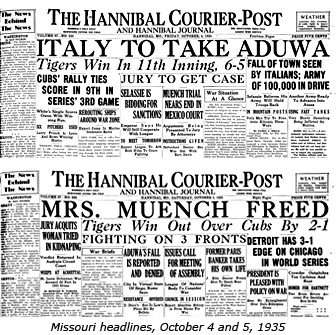 |
|||||||||||||||||||
 |
|||||||||||||||||||
 |
|||||||||||||||||||
|
|
|||||||||||||||||||
 |
|||||||||||||||||||
|
When historians examine a particular story in a newspaper, they also often examine other stories appearing in the paper on that day. Looking at a story in the context of the larger newspaper can offer clues to the importance the editors assigned to the story and to how appealing they believed the story would be to the newspapers’ readers. For example, it is usually safe to assume that stories positioned “above the fold”—that is, in the top half of the front page of the paper—were assigned a much greater priority either because they made a point the editors of the paper wanted to emphasize, or because readers were more likely to want to read that story than others. If, however, the story in question appeared in the bottom left corner of Page 7, squeezed against the margin by a large advertisement, it is usually safe to assume that the editors assigned much less significance or potential appeal to that story.
For example, according to The Washington Post, during the months before the outbreak of the war in Iraq in 2003, the paper’s editors buried stories questioning such things as the existence of weapons of mass destruction in Iraq, while placing stories featuring the Bush Administration’s war plans on the front page. Editors at the Post subsequently described their decisions on story placement as “a mistake.”
Positioning, however, is not everything. Just because
a story appears on Page 12 rather than Page 1 does not mean that the editors
do not believe it to be important. It is also possible that the story
you are reading is the sixth or seventh installment in a long-running
For this reason, understanding how the story you are reading relates to the others in the paper often requires looking at not only one edition of the paper, but several days worth of newspapers before and after the story in question. Is what you are reading a continuing story? Is it the first appearance of a series of stories? Is it the end of a long investigation? Answers to these sorts of questions can only be found through reading more than the story in front of you.
Modern databases such as ProQuest Historical Newspapers are a wonderful tool for researchers, but have the disadvantage of serving up stories in isolation. They present stories as though they had no relationship to everything else in the paper on a given day. If you are using such a database, be aware that you are seeing only a one-story snapshot of a complex document that contained many stories, graphics and advertisements, all of which help you to understand what you are reading.
|
||||||||||
|
finding world history | unpacking evidence | analyzing documents | teaching sources | about |
||
 story that the editors assume their readers are already familiar with.
Breaking news often finds its way onto the front page of a newspaper because
it is new, not necessarily because it is deemed to be more important
than another story.
story that the editors assume their readers are already familiar with.
Breaking news often finds its way onto the front page of a newspaper because
it is new, not necessarily because it is deemed to be more important
than another story.